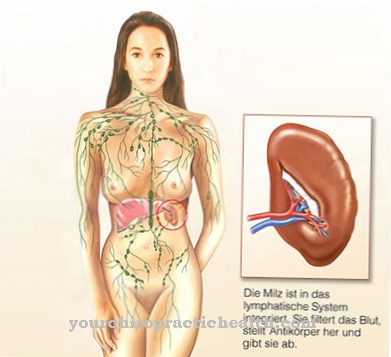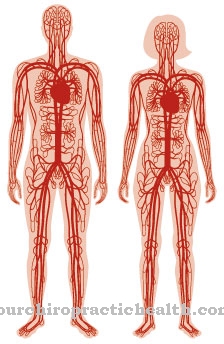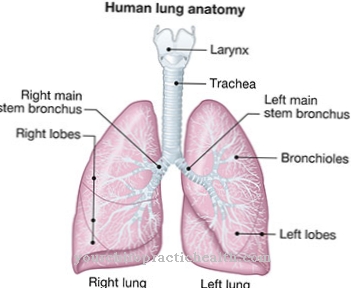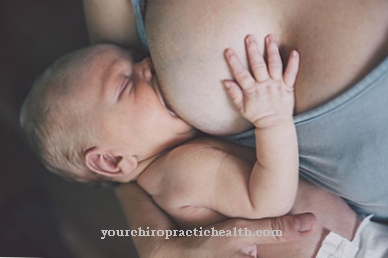The Geroderma osteodysplastica is one of the rare genetic diseases. It is characterized by premature aging of the skin and decalcification of the bones. But life expectancy is not restricted.
What is geroderma osteodysplastica?

© Love the wind - stock.adobe.com
Geroderma osteodysplastica is a disease of the connective tissue and the bones. It is hereditary and has a very rare prevalence. Only around one in a million people is affected. The connective tissue ages prematurely. At least it appears to have aged due to its wrinkled and wrinkled appearance, as it has a malformation. In addition, severe osteoporosis with frequent bone fractures already occurs in childhood.
The main symptoms of the disease are already indicated in the name of the disease. "Geroderma" means old skin and "osteodysplastica" means bone malformation. The expression Bamatter-Franceschetti-Klein-Sierro Syndrome used. This name refers to the first discoverer of this disease.
Together with the ophthalmologist Adolphe Franceschetti from Geneva, the doctor A. Sierro and the human geneticist David Klein, this syndrome was described by the Swiss pediatrician Frédéric Bamatter in 1950. Scientists from the Max Planck Institute for Molecular Genetics in Berlin, under the direction of Stefan Mundlos, examined 13 families who developed this disease. Members of these families were particularly common among the Mennonite denominations.
causes
A genetic defect is a possible cause of the geroderma osteodysplastica. In many cases, the GORAB gene on chromosome 1 is affected by a mutation. Strangely enough, however, this mutation is not found in every person affected. The inheritance is autosomal recessive. Recently, patients have also been discovered who have a mutation on the PYCR1 gene on chromosome 17.
In this form of the disease, there is a particularly strong clinical overlap of the symptoms with the Cutis-Laxa syndrome and the wrinkly skin syndrome. It must therefore be assumed that Geroderma osteodysplastica is not a uniform disease, but rather a collective syndrome of several clinically similar diseases. About 13 families were examined in which the relatives had several cases of the disease. Thus, this disease does not occur spontaneously.
Symptoms, ailments & signs
Geroderma osteodysplastica is characterized by the fact that newborns already have sagging, old-looking skin. This is caused by a defective structure of the connective tissue. The joints can be overstretched. In addition, growth disorders occur in children. Those affected suffer from short stature. Osteoporosis is particularly pronounced.
It occurs in a generalized manner all over the body and causes permanent bone fractures. There is also hip dysplasia. The cause of osteoporosis is to be found in the generalized decalcification processes within the bones. The head shows brachycephaly with a bulging forehead. Brachycephaly manifests itself as a deformation of the skull, which leads to so-called short-headedness. The eyes are also affected.
Occasionally a microcornea (cornea that is too small) occurs. The cornea is also cloudy and glaucoma (green star) can also occur. General developmental disorders are also observed. Mental development is usually normal. At times a small intellectual deficit may arise.
The greatest evidence of a geroderma osteodysplastica is the pronounced osteoporosis with spontaneously occurring fractures and a lack of open fontanel in newborns. The life expectancy of those affected is not restricted. In the course of life, the frequency of fractures even decreases. Otherwise, the symptoms will improve.
diagnosis
The differential diagnosis of geroderma osteodysplastica is not so easy to distinguish from cutis laxa syndromes, wrinkly skin syndrome (WSS) and De Barsy syndrome. The unique selling point of geroderma osteodysplastica, however, is the combination of generalized osteoporosis together with the lack of an open fontanel. In contrast to the other syndromes of this type, the physical limitations are not so great. Furthermore, mental development is usually completely normal.
Complications
As a rule, geroderma osteodysplastica does not lead to a reduction in life expectancy. However, the patient suffers from premature aging of the skin, although the bones are also decalcified. A wrong structure in the connective tissue makes it possible for those affected to paint over the joints and thus damage them.
This increases the risk of accidents, especially with children. It is not uncommon for the patients to develop short stature. The skull is deformed and usually relatively short. Due to the malformations, children can suffer from bullying and teasing and thus develop psychological complaints and depression.
Developmental disorders also continue to occur, with an intellectual disorder also occurring. In some cases, the person concerned is then dependent on the help of other people or carers in everyday life. The discomfort in the bones can also cause spontaneous fractures, which are associated with very severe pain.
The treatment of geroderma osteodysplastica is only possible symptomatically. Eye complaints can be remedied relatively well, so that there are no further complications. In many cases, the patient is also dependent on psychological therapy.
When should you go to the doctor?
In the case of growth disorders, changes in bone structure or short stature, a doctor's visit is required. If the child shows development disorders in direct comparison with their peers, a doctor should be consulted. If you have a learning disability, comprehension problems, a reduced intelligence, concentration or attention deficits, it is advisable to consult a doctor.
If there are more and more broken bones of all kinds, a discussion with a doctor should be sought. If the joints are hyperextended or if there is pain while moving, a doctor's visit is required. Deformations of the skull are considered a cause for concern. If you have a bulging forehead, short headedness or visual changes in the area of the eyes, you should consult a doctor for clarification. If irregularities in the connective tissue can be discovered at an early age, the observation should be discussed with a doctor.
If the child shows behavioral problems, if they are particularly restless or aggressive, a doctor's visit is necessary. A doctor is needed in the event of social withdrawal, whiny or melancholy behavior, as well as a depressive mood. If the child shows difficulties in making contact, has increased anxiety due to the symptoms and refuses to participate in sporting activities, a visit to the doctor is required to reduce the symptoms. If sleep disorders occur, digestive problems or headaches occur, there may be psychosomatic complaints that need to be investigated.
Doctors & therapists in your area
Treatment & Therapy
Treatment of the geroderma osteodysplastica is symptomatic. A causal therapy is not possible because it is a genetic defect. However, the limitations are not as great as in many similar diseases of the cutis laxa syndrome. Only generalized osteoporosis requires constant monitoring and therapy. The administration of biphosphates has proven to be very effective here.
It goes without saying that the frequently occurring bone fractures must be treated at all times. However, over the course of life, the fractures gradually decrease. The bone metabolism normalizes. Eye complaints also require constant monitoring. This can cloud the cornea and even develop glaucoma.
Of course, the ophthalmologist must monitor further developments. However, the eye symptoms are not mandatory. The affected person has progeroid characteristics. However, the aging process does not progress as quickly as in the case of classic progeria. The wrinkled and wrinkled skin is not an expression of real aging, but is caused by the malformation of the connective tissue.
Outlook & forecast
Geroderma osteodysplastica is a disease that is considered incurable. The prognosis is therefore not very optimistic. The genetic defect cannot be changed or corrected. According to the current status, legal requirements prevented an intervention in human genetics. For this reason, the treatment of the patient depends on the individual symptoms, although not all can experience relief.
The existing complaints can also lead to further secondary illnesses and trigger emotional problems.Due to the visual aging and the limitations of the disease, many patients suffer from mental disorders. These are treatable but mostly characterized by a long healing process.
Developmental disorders as well as decreased intelligence are possible with geroderma osteodysplastica. Although support programs are created and used, they mostly only provide support in coping with everyday life. There is no cure.
The aim is to improve general well-being and enable a good lifestyle with the disease. In many cases, however, daily care by carers or relatives is necessary, as it is not possible to lead an independent lifestyle. Despite the numerous impairments of the disease and its incurability, the general life expectancy of those affected is not reduced. There is also a good chance of improving eyesight once it has been impaired.
prevention
To prevent geroderma osteodysplastica, genetic counseling should be sought. Geroderma osteodysplastica is hereditary with an autosomal recessive inheritance. However, the mutated gene is very rare, with a prevalence of one in a million.
The likelihood of this disease being inherited is only increased within related marriages in the affected families. In the case of a recessive inheritance, the probability of the offspring being born with this disease is 50 percent for marriages in which both partners are gene carriers.
Aftercare
In most cases of geroderma osteodysplastica no special follow-up options are possible. However, these are not necessary as the disease cannot be treated completely. If the patient wishes to have children, genetic counseling can also be carried out so that the disease is not passed on to potential offspring.
A causal treatment is not possible due to the genetic disease, so that those affected are dependent on lifelong, purely symptomatic therapy. In most cases, patients are dependent on medication. It is important to ensure that it is taken correctly and regularly to prevent further compilations.
The eyes should also be checked regularly to avoid clouding. In the worst case, the geroderma osteodysplastica can lead to complete blindness of the affected person. However, the life expectancy of the patient is not limited or reduced by the disease.
Contact with other patients with geroderma osteodysplastica can also be useful. It is not uncommon for valuable information to be exchanged, which can make everyday life easier. Support from your own family can also significantly alleviate the symptoms.
You can do that yourself
Although patients with geroderma osteodysplastica are visually noticeable, social withdrawal behavior out of shame is counterproductive. In order to keep the quality of life as high as possible, the sick maintain social contacts and carry out normal activities in public spaces.
Contacts with other people with geroderma osteodysplastica or similar diseases are particularly helpful in order to share experiences and give each other social support. However, it makes sense not to spend time exclusively with other sick people, but also with people without such diseases.
With regard to the susceptibility to bone fractures, the patients attach particular importance to accident prevention in everyday life and avoid risky activities and movements. If there are still bones broken, it is important to allow yourself enough rest and thus promote recovery.
Physiotherapeutic exercises to strengthen tendons and muscles are also important, in order to prevent certain accidents and improve general mobility. Usually, patients with geroderma osteodysplastica are undergoing physiotherapeutic treatment and are therefore familiar with individually sensible training options. The strengthening effects of these exercises increase if the patient also does them independently at home. Regular agreements with the doctor and physiotherapist are essential.




.jpg)






















